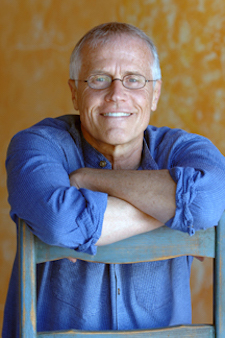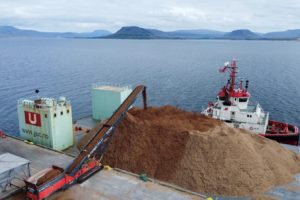Paul Hawken acknowledges that the subtitle of his latest book, Drawdown: The Most Comprehensive Plan Ever Proposed to Reverse Global Warming, is brash. But the author and entrepreneur says he can get away with it because the plan he and his collaborators put forward is the first and only of its kind.
“We’ve never mapped, measured, and modeled the top solutions to global warming, after 40 years of this being in the public sphere,” he says in an interview with Yale Environment 360. With this plan, he contends, “we have in hand now, in a practical way, the solutions that are needed in order to reverse global warming.”
The book, which he edited, represents the work of Project Drawdown , the organization he founded with the mission of researching and promoting a path to drawdown, the point at which the concentration of greenhouse gases begins to decline. The volume includes descriptions of 100 of those solutions, 80 of which are currently in practice. As Hawken puts it, “There are no wannabes.”
The solutions are ranked by the number of gigatons of CO2, or the equivalent, that they would avoid or sequester between the years 2020 and 2050. They range from big difference-makers such as refrigerant management, wind turbines, and food waste to those that are important but not as impactful, including methane digesters, green roofs, and microgrids.
When it comes to global warming, Hawken says, we’ve been “focusing too much on the problem instead of the solution…. Regenerative development is development, whether it’s on an urban, transportation, housing, marine agriculture, or health level. It’s development that actually heals the future as opposed to stealing from it, which is what we’re doing today.”
Yale Environment 360: In 2001 you began to ask experts for ideas on how to actually reverse, as opposed to stabilize, global warming. In this book, you describe what you were looking for as a shopping list of sorts. But you say those experts told you, “Good idea, but we don’t know,” so you ended up taking on the project yourself.
Paul Hawken: I think a lot of people felt that we had our arms wrapped around this problem in terms of what we needed to do. But I wanted to know where we stood and can we name the goal. Because, to me, stabilization, reducing the rate of emissions, and mitigation did not make sense as goals. To this day, I don’t understand that goal. It seemed a little weak-kneed and bowing to industrial momentum.
e360: The book lists 80 solutions that are in practice now that can scale up. They’re ranked by the number of gigatons of CO₂, or the equivalent thereof, that they could potentially avoid or remove between 2020 and 2050. Your No. 1 solution has the slightly less than compelling title of refrigerant management. This solution involves reining in HFCs, which are super-potent greenhouse gases, and Drawdown estimates that 90 gigatons of carbon dioxide can be avoided. Talk a bit about the problem with HFCs and the solution.
Hawken: I would preface by saying that we were very surprised by the top 10 solutions, and we didn’t see that one coming. If you add the Kigali amendment to the Montreal Protocol [to protect the ozone layer] and the estimates as to what that would do in terms of reduction of hydrofluorocarbons, that figure gets even larger. We erred on the conservative side over and over again because we didn’t want anybody to look at this and say, “They didn’t do their homework,” or, “They egged the pudding.” On that one especially, refrigerant management, we’re definitely low. We know it’s much more than that, but we didn’t have a methodology to really understand the projections going forward from the Kigali amendment.
When [the book] came out, the refrigeration industry was thrilled because they’re retrofitting refrigeration systems all over the world. They said there are already 10,000 supermarkets in the United States that have swapped out to propane, ammonia, and other approved substitutes from HFCs.
e360: But isn’t the disposal end of things the most problematic?
Hawken: Yes.
e360: What’s the solution to disposal of HFCs?
Hawken: The solution is capture and re-use in some countries, and capture and incinerate in certified destruction facilities. The European Union standards are the highest, followed by the U.S. It is more problematic in lower-income nations.
e360: And you fully anticipate it will be scaling up?
Hawken: It is scaling. Every solution of the 80 is in place, in hand. That was a very important qualification. There are no wannabes.
“If you had asked us at the outset to name the top five or 10 solutions, we would have gotten them wrong.”
e360: I’d like to talk a bit about the research that went into the solutions. For instance, the solution that was ranked number 35 is bamboo. It’s a super sequester that can thrive on degraded land. Drawdown research concludes it could plausibly be grown on an additional 37 million acres of degraded or abandoned land and potentially sequester over seven gigatons of CO₂ by 2050. The investment required is $24 billion. It yields, I believe, more than 10 times that amount in return. Who’s doing those calculations? Who’s reviewing them?
Hawken: We have 70 research fellows from around the world. Each of them took one or, in some cases, two solutions and wrote basically a master’s thesis on them. They did a literature review. There’s about 5,000 references for those 80 solutions, which are now being published on the website. Our goal is transparency. The methodology was a three-step review process. It’s reviewed internally, it’s reviewed by the advisors, then the model is reviewed by outside expert science reviewers.
e360: It’s stunning to consider that if you combine solution number six, universal education of girls through secondary school, with solution number seven, access to family planning for women who want it, you get a reduction in CO₂ that far exceeds that number one solution of refrigerant management.
Hawken: It belongs in what we at Drawdown call the “who knew?” category. We didn’t, that’s for sure. But the data, again, is straight up. United Nations population projections for 2050 are either 9.7 or 10.8 billion. The UN is very clear that the difference can be almost entirely attributed to the access to family planning and use of it. Educating girls is one pathway to family planning, and the other pathway is having clinics available to women all over the world to support their reproductive health and well-being and choices. It’s a total of 119.2 gigatons [of avoided CO2 emissions]. We split it down the middle, 59.6 each, because there’s really no bright line there.
e360: Since the book came out, what are you hearing behind closed doors or otherwise about family planning?
Hawken: What we hear is a lot of organizations that were working on education for girls and working on family planning and population didn’t make that linkage to climate change. They’re really thrilled to see that it’s important in one of the biggest conversations in the world that’s going on: climate change.
e360: You and your colleagues write in the book, “As researchers, we were and remain astonished at the impact individual solutions can have, especially as they relate to both production and consumption of food.” Talk a bit about that.
Hawken: Again, if you had asked us at the outset to name the top five or 10 solutions, we would have gotten them wrong. We wouldn’t have seen food as being as important as it turned out to be. Once it did, we went back and checked. “Whoa. Let’s be sure.” What we discovered and what I think we really knew is that actually [our calculations] are conservative. For example, on reducing food waste, we don’t count methane emissions from the landfill from food. That’s a huge number. Again, why we don’t count it is because we didn’t know how to measure it. We didn’t have data that was credible there, so we didn’t put it in. But that doesn’t mean it’s not happening. That would make reduced food waste even higher than the number three solution.
In the plant-rich diet solution, we avoided some pitfalls. The idea isn’t that you have to be a vegetarian or not eat any meat. What we tried to do is reduce protein levels in our model to healthy levels in developed countries and bring them up to standard where there was protein deficiency in lower-income countries, along with caloric intake. In other words, we have the world eating a healthy diet and with more plant-based protein, but not eliminating animal protein at all. Yet, even then, it came to be the number four solution, because of the impact that CAFOs [Confined Animal Feeding Operations] and raising meat has on the environment, which is quite extraordinary.
“The messaging solution about climate change that’s been put forth so far has actually not worked at all.”
e360: You also write in the book that “global warming should be seen as an invitation to build, innovate, and affect change.” You go on to say, “This is not a liberal agenda nor is it a conservative agenda; this is a human agenda.” Given the reality of just how far from adopting that statement the Trump administration is, how important is it, in your estimation, to not have the U.S. federal government actively working towards a reduction in global warming?
Hawken: Look, basically we have a wrecking ball in the White House who’s really undoing America, and the rule of law, and science. With respect to the Paris [climate] agreement, the showboating of Trump saying he’s going to pull out, actually, it was a big help, because most Americans didn’t know what the Paris agreement was. What it did was create this coalescence, led by many people, for cities and respected institutions, corporations, universities, churches around the country to say, “I’m in. This is my commitment. We’re going to double down.”
The federal government has never led on climate, ever. It’s tried to, but it has never, because of Congress. You saw the J.P. Morgan report that came out [recently] that said basically renewable energy prices are continuing to crash and that we’re going to meet the Paris agreement whether Trump likes it or not because of the rapidity of the growth of renewable energy.
e360: Project Drawdown is working with the Commonwealth of Nations on an initiative called the Regenerative Development to Reverse Climate Change [RDRCC]. Talk about that work.
Hawken: The Commonwealth includes many low-lying nations where climate change and ocean sea level rise is not an abstraction. They experience it. Looking at the data, they know that in many cases their whole island or islands would be wiped out, or all their agricultural land on that island would be wiped out, in this century. That, I think, has really made a big impact on the whole of the Commonwealth and engendered the RDRCC [initiative], which is based on Drawdown.
From Project Drawdown’s point of view, the messaging solution about climate change that’s been put forth so far has actually not worked at all. The messaging has been about 2 degrees Centigrade [the maximum temperature increase if the world is to avoid the worst impacts of climate change], and 2 degrees means nothing to 99.999 percent of people in the world. Not a thing. It has no impact on their life. Then, on top of that, studies show that the human brain is not wired to deal with future existential threats.
What we’re saying at Drawdown is that we’re going in through a locked back door to humanity, and the front door is wide open. That front door is needs assessment, what every human being needs, which is security, a living wage, jobs that give them a sense of purpose. We’re the only species without full employment, and never has been so much work been needed to be done. Regenerative development is development, whether it’s on an urban, transportation, housing, marine agriculture, or health level. It’s development that actually heals the future as opposed to stealing from it, which is what we’re doing today, and we’re calling that GDP [Gross Domestic Product].
“The way we’re going to solve this problem is with development processes that actually make human life better.”
We’re stealing our future and selling it. Regenerative development is the opposite. It’s not as though we have to say, “OK, let’s do this for climate and this for biodiversity and this for human health.” The regenerative development addresses all of them simultaneously. That’s the front door.
The way we’re going to solve this problem is with development processes that actually make human life better. That’s what people will always move towards, but they’re not going to move towards two degrees and guilt and shame.
Individuals are told that they should drive less and eat this and do that, and they know that that’s important but it’s not sufficient. You get a country that’s divided, that’s numb, that turns off. RDRCC really is an attempt to flip all that and say, “Actually, the path towards reversing climate change is a pathway towards increasing the quality of life for people on this island or this nation, and this is how it plays out in these different sectors.”
e360: Project Drawdown has a let’s-roll-up-our-sleeves-and-fix-this kind of tone. Do you think that some are now realizing that’s a better message, rather than an everything’s-going-to-hell-in-a-handbasket one?
Hawken: It’s not a question of either/or. But I will say that a constant focus on the problem doesn’t solve the problem. Once you have a problem statement, what you don’t want to do is basically just push people’s face into it all the time. What you want to do is say, “Let’s go solve the problem.”
What Drawdown is basically saying to the world is we’re focusing too much on the problem instead of the solution. We’ve never mapped, measured, and modeled the top solutions to global warming after 40 years of this being in the public sphere. We have in hand now, in a practical way, the solutions that are needed in order to reverse global warming. If they continue to scale in a rigorous but reasonable way, can we in fact achieve that tipping point where greenhouse gases peak and then go down on a year-to-year basis? The answer is yes.
Somebody can come back at us and say, “That’s very difficult.” Yeah, OK. But, better know that we can do it and it’s difficult than to not know it at all. It doesn’t mean it’s going to be easy. It doesn’t mean the odds aren’t long. But at least it means that we actually know that there is a pathway through that we have at hand.



